Semi-Arid to Arid Scenario Shift: Is the Cabrobó Desertification Nucleus Becoming Arid?
Abstract
1. Introduction
2. Materials and Methods
2.1. Characterization of the Desertification Nucleus of Cabrobó
2.2. Geospatial Data from MapBiomas Brazil and Landsat 5/TM and 8/OLI
2.3. SAVI
2.4. TerraClimate Data
2.5. Aridity Index (AI)
2.6. Statistical Analysis
3. Results and Discussion
3.1. Geospatial Data from MapBiomas Brazil
3.2. SAVI
3.3. Data from Orbital Sensors (TerraClimate)
3.3.1. Validation of TerraClimate Data
3.3.2. Space–Time Analysis of Precipitation for the DNC
3.3.3. SPI
3.3.4. Actual Evapotranspiration (ETa)
3.3.5. Average Air Temperature
3.3.6. Aridity Index (AI)
4. Conclusions
Author Contributions
Funding
Data Availability Statement
Acknowledgments
Conflicts of Interest
Abbreviations
| DNC | Desertification Nucleus of Cabrobó |
| ENSO | El Niño–Southern Oscillation |
| ETa | actual evapotranspiration |
| ETo | potential evapotranspiration |
| GEE | Google Earth Engine |
| INMET | National Institute of Meteorology |
| IQR | interquartile range |
| ITCZ | Intertropical Convergence Zone |
| LAI | Leaf Area Index |
| LULC | land use and land cover |
| NEB | Northeast Brazil |
| NOAA | National Oceanic and Atmospheric Administration |
| ONI | Oceanic Niño Index |
| PR2 | precipitationcoefficient of determination |
| RMSE | root mean square error |
| SAVI | Soil-Adjusted Vegetation Index |
| SPI | Standardized Precipitation Index |
| SST | Sea Surface Temperature |
| SSTA | Sea Surface Temperature Anomaly |
| ULCVs | Upper-Level Cyclonic Vortices |
| UNCCD | United Nations Convention to Combat Desertification |
| VHI | Vegetation Health Index |
References
- Thornton, P.K.; Ericksen, P.J.; Herrero, M.; Challinor, A.J. Climate Variability and Vulnerability to Climate Change: A Review. Glob. Chang. Biol. S 2014, 20, 3313–3328. [Google Scholar] [CrossRef] [PubMed]
- Gustafson, E.J.; Miranda, B.R.; Shvidenko, A.Z.; Sturtevant, B.R. Simulating Growth and Competition on Wet and Waterlogged Soils in a Forest Landscape Model. Front. Ecol. Evol. 2020, 8, 598775. [Google Scholar] [CrossRef]
- Singh, R.; Ram, K.; Yadav, C.; Siddiqui, A.R. Climate Change, Disaster and Adaptations: Human Responses to Ecological Changes. In Climate Change, Disaster and Adaptations; Springer: Cham, Switzerland, 2022; pp. 121–130. [Google Scholar]
- Boiffin, J.; Munson, A.D. Three Large Fire Years Threaten Resilience of Closed Crown Black Spruce Forests in Eastern Canada. Ecosphere 2013, 4, 1–20. [Google Scholar] [CrossRef]
- de Oliveira-Júnior, J.F.; Mendes, D.; Szabo, S.; Singh, S.K.; Jamjareegulgarn, P.; Cardoso, K.R.A.; Bertalan, L.; da Silva, M.V.; da Rosa Ferraz Jardim, A.M.; da Silva, J.L.B.; et al. Impact of the El Niño on Fire Dynamics on the African Continent. Earth Syst. Environ. 2024, 8, 45–61. [Google Scholar] [CrossRef]
- dos Santos, J.C.; Lyra, G.B.; Abreu, M.C.; de Oliveira-Júnior, J.F.; Bohn, L.; Cunha-Zeri, G.; Zeri, M. Aridity Indices to Assess Desertification Susceptibility: A Methodological Approach Using Gridded Climate Data and Cartographic Modeling. Nat. Hazards 2022, 111, 2531–2558. [Google Scholar] [CrossRef]
- dos Santos, T.S. Projeção Da Suscetibilidade a Desertificação Em Pernambuco Utilizando o Modelo HADGEM-ES (Projection of Susceptibility to Desertification in Pernambuco Using the HADGEM-ES Model). Rev. Bras. Geogr. Física 2017, 10, 1170. [Google Scholar] [CrossRef][Green Version]
- Zolotokrylin, A.N. Global Warming, Desertification/Degradation, and Droughts in Arid Regions. Izv. Ross. Akad. Nauk. Seriya Geogr. 2019, 3–13. [Google Scholar] [CrossRef]
- Bohn, L.; Lyra, G.B.; Oliveira-Júnior, J.F.; Zeri, M.; Cunha-Zeri, G. Desertification Susceptibility over Rio de Janeiro, Brazil, Based on Aridity Indices and Geoprocessing. Int. J. Climatol. 2021, 41, E2600–E2614. [Google Scholar] [CrossRef]
- Nóbrega, R.S.; Farias, R.F.D.L.; Santos, C.A.C.D. Variabilidade Temporal e Espacial Da Precipitação Pluviométrica Em Pernambuco Através de Índices de Extremos Climáticos. Rev. Bras. Meteorol. 2015, 30, 171–180. [Google Scholar] [CrossRef]
- Soares, D.B.; Nóbrega, R.S.; Mota Filho, F.D.O. Sobre o Processo de Desertificação. Rev. Bras. Geogr. Física 2011, 4, 174–188. [Google Scholar] [CrossRef]
- Vieira, R.M.D.S.P.; Tomasella, J.; Barbosa, A.A.; Martins, M.A.; Rodriguez, D.A.; Rezende, F.S.D.; Carriello, F.; Santana, M.D.O. Desertification Risk Assessment in Northeast Brazil: Current Trends and Future Scenarios. Land Degrad. Dev. 2021, 32, 224–240. [Google Scholar] [CrossRef]
- Moura, M.M.; Walter, L.S.; Lins, T.R.D.S.; Araujo, E.C.G.; da Cunha Neto, E.M.; Santana, G.M.; Brasil, I.D.S.; Silva, T.C. Temporal Analysis of Desertification Vulnerability in Northeast Brazil Using Google Earth Engine. Trans. GIS 2022, 26, 2041–2055. [Google Scholar] [CrossRef]
- Moraes, J.B.; Wanderley, H.S.; Delgado, R.C. Areas Susceptible to Desertification in Brazil and Projected Climate Change Scenarios. Nat. Hazards 2022, 116, 1463–1483. [Google Scholar] [CrossRef]
- de Oliveira Júnior, J.G.; Lopes, P.M.O.; Nascimento, C.R.; Moura, G.B.D.A.; de Oliveira Júnior, J.F. Space-Temporal Detection of Environmental Changes in the Brazilian Semiarid through Google Earth Engine and GIS. J. S. Am. Earth Sci. 2023, 127, 104403. [Google Scholar] [CrossRef]
- Neves, L.V.D.M.W.; de Sousa, J.E.S.; dos Santos, J.C.B.; de Araújo Filho, J.C.; Corrêa, M.M.; Sousa, M.G.; Fracetto, F.J.C.; Fracetto, G.G.M.; Araujo, J.K.S.; Freire, G.A.P.; et al. Weathering of Gneiss Saprolites and Formation of Planosols under Semiarid Climate (NE Brazil). J. S. Am. Earth Sci. 2023, 123, 104206. [Google Scholar] [CrossRef]
- de Lucena, J.A.; Nóbrega, R.S.; de Albuquerque, L.S. Anomalias de Temperatura Da Superfície Do Mar e a Variabilidade Pluviométrica No Núcleo de Desertificação de Cabrobó/PE. Rev. Geogr. 2017, 34, 239–256. [Google Scholar] [CrossRef]
- Feng, K.; Wang, T.; Liu, S.; Yan, C.; Kang, W.; Chen, X.; Guo, Z. Path Analysis Model to Identify and Analyse the Causes of Aeolian Desertification in Mu Us Sandy Land, China. Ecol. Indic. 2021, 124, 107386. [Google Scholar] [CrossRef]
- Liu, Q.; Zhang, Q.; Yan, Y.; Zhang, X.; Niu, J.; Svenning, J.-C. Ecological Restoration Is the Dominant Driver of the Recent Reversal of Desertification in the Mu Us Desert (China). J. Clean. Prod. 2020, 268, 122241. [Google Scholar] [CrossRef]
- Costa, G.B.; Mendes, K.R.; Viana, L.B.; Almeida, G.V.; Mutti, P.R.; e Silva, C.M.S.; Bezerra, B.G.; Marques, T.V.; Ferreira, R.R.; Oliveira, C.P.; et al. Seasonal Ecosystem Productivity in a Seasonally Dry Tropical Forest (Caatinga) Using Flux Tower Measurements and Remote Sensing Data. Remote Sens. 2022, 14, 3955. [Google Scholar] [CrossRef]
- Caetano, R.; Bastos Silva, T.; Ribeiro de Castro, D.; Silva Benfica, N. Uso de Índices Espectrais Na Caracterização Da Cobertura Vegetal Em Região de Caatinga Do Semiárido Baiano. Rev. Geociências Do Nordeste 2022, 8, 28–43. [Google Scholar] [CrossRef]
- Pande, C.B.; Al-Ansari, N.; Kushwaha, N.L.; Srivastava, A.; Noor, R.; Kumar, M.; Moharir, K.N.; Elbeltagi, A. Forecasting of SPI and Meteorological Drought Based on the Artificial Neural Network and M5P Model Tree. Land 2022, 11, 2040. [Google Scholar] [CrossRef]
- Thornthwaite, C.W. An Approach toward a Rational Classification of Climate. Geogr. Rev. 1948, 38, 55. [Google Scholar] [CrossRef]
- de Gois, G.; de Souza, J.L.; da Silva, P.R.T.; de Oliveira-Júnior, J.F. Caracterização Da Desertificação No Estado de Alagoas Utilizando Variáveis Climáticas. Rev. Bras. Meteorol. 2005, 20, 301–314. [Google Scholar]
- de Lucena, J.A.; Nóbrega, R.S.; Wanderley, L.S.D.A. Aspectos Temporais, Espaciais e Rítmicos Da Variabilidade Pluviométrica No Núcleo de Desertificação de Cabrobó/PE. Rev. Bras. Geogr. Física 2017, 10, 1784–1801. [Google Scholar] [CrossRef][Green Version]
- Perez-Marin, A.M.; Cavalcante, A.D.M.B.; Medeiros, S.S.; Tinôco, L.D.M.; Salcedo, I.H. Núcleos de Desertificação No Semiárido Brasileiro: Ocorrência Natural Ou Antrópica? Parcer. Estratégicas 2012, 17, 87–106. [Google Scholar]
- Dubreuil, V.; Fante, K.P.; Planchon, O.; Sant’Anna Neto, J.L. Climate Change Evidence in Brazil from Köppen’s Climate Annual Types Frequency. Int. J. Climatol. 2019, 39, 1446–1456. [Google Scholar] [CrossRef]
- Lyra, G.B.; Oliveira-Júnior, J.F.; Gois, G.; Cunha-Zeri, G.; Zeri, M. Rainfall Variability over Alagoas under the Influences of SST Anomalies. Meteorol. Atmos. Phys. 2017, 129, 157–171. [Google Scholar] [CrossRef]
- Costa, M.D.S.; Oliveira-Júnior, J.F.D.; Santos, P.J.D.; Correia Filho, W.L.F.; Gois, G.D.; Blanco, C.J.C.; Teodoro, P.E.; Silva Junior, C.A.D.; Santiago, D.D.B.; Souza, E.D.O.; et al. Rainfall Extremes and Drought in Northeast Brazil and Its Relationship with El Niño–Southern Oscillation. Int. J. Climatol. 2021, 41, E2111–E2135. [Google Scholar] [CrossRef]
- Abreu, M.C.; de Souza Fraga, M.; Lyra, G.B.; de Oliveira Junior, J.F.; de Jesús Villar-Hernández, B.; de Souza, A.; Zeri, M. Long-term Trend Analysis in Annual, Seasonal and Monthly Rainfall in East Northeast of Brazil and the Influence of Modes of Climate Variability. Int. J. Climatol. 2023, 43, 7463–7480. [Google Scholar] [CrossRef]
- NOAA Cold & Warm Episodes by Season. Available online: https://origin.cpc.ncep.noaa.gov/products/analysis_monitoring/ensostuff/ONI_v5.php (accessed on 14 September 2023).
- Eid, A.N.M.; Olatubara, C.O.; Ewemoje, T.A.; El-Hennawy, M.T.; Farouk, H. Inland Wetland Time-Series Digital Change Detection Based on SAVI and NDWI Indecies: Wadi El-Rayan Lakes, Egypt. Remote Sens. Appl. 2020, 19, 100347. [Google Scholar] [CrossRef]
- Nagy, A.; Szabó, A.; Adeniyi, O.D.; Tamás, J. Wheat Yield Forecasting for the Tisza River Catchment Using Landsat 8 NDVI and SAVI Time Series and Reported Crop Statistics. Agronomy 2021, 11, 652. [Google Scholar] [CrossRef]
- Silva, M.D.; Pandorfi, H.; Lopes, P.M.O.; Silva, J.D.; Almeida, G.L.P.; Silva, D.D.O.; Santos, A.D.; Rodrigues, J.D.M.; Batista, P.H.D.; Jardim, A.M.R.F. Pilot Monitoring of Caatinga Spatial-Temporal Dynamics through the Action of Agriculture and Livestock in the Brazilian Semiarid. Remote Sens. Appl. 2020, 19, 100353. [Google Scholar] [CrossRef]
- West, H.; Quinn, N.; Horswell, M. Remote Sensing for Drought Monitoring & Impact Assessment: Progress, Past Challenges and Future Opportunities. Remote Sens. Environ. 2019, 232, 111291. [Google Scholar] [CrossRef]
- Huete, A.; Didan, K.; Miura, T.; Rodriguez, E.P.; Gao, X.; Ferreira, L.G. Overview of the Radiometric and Biophysical Performance of the MODIS Vegetation Indices. Remote Sens. Environ. 2002, 83, 195–213. [Google Scholar] [CrossRef]
- da Silva, J.L.B.; de Albuquerque Moura, G.B.; da Silva, M.V.; Lopes, P.M.O.; de Souza Guedes, R.V.; de França e Silva, Ê.F.; Ortiz, P.F.S.; de Moraes Rodrigues, J.A. Changes in the Water Resources, Soil Use and Spatial Dynamics of Caatinga Vegetation Cover over Semiarid Region of the Brazilian Northeast. Remote Sens. Appl. 2020, 20, 100372. [Google Scholar] [CrossRef]
- Silva, C.O.F.; Jandreice Magnoni, P.H.; Lilla Manzione, R. Orbital Remote Sensing for Evapotranspiration Modeling: Theoretical Overview and Applications in Cloud Computing. Rev. Bras. Eng. Biossistemas 2021, 15, 425–468. [Google Scholar] [CrossRef]
- da Silva, M.V.; Pandorfi, H.; de Oliveira-Junior, J.F.; da Silva, J.L.B.; de Almeida, G.L.P.; de Assunção Montenegro, A.A.; Mesquita, M.; Ferreira, M.B.; Santana, T.C.; Marinho, G.T.B.; et al. Remote Sensing Techniques via Google Earth Engine for Land Degradation Assessment in the Brazilian Semiarid Region, Brazil. J. S. Am. Earth Sci. 2022, 120, 104061. [Google Scholar] [CrossRef]
- Liu, C.; Yang, C.; Yang, Q.; Wang, J. Spatiotemporal Drought Analysis by the Standardized Precipitation Index (SPI) and Standardized Precipitation Evapotranspiration Index (SPEI) in Sichuan Province, China. Sci. Rep. 2021, 11, 1280. [Google Scholar] [CrossRef] [PubMed]
- Lloyd-Hughes, B.; Saunders, M.A. A Drought Climatology for Europe. Int. J. Climatol. 2002, 22, 1571–1592. [Google Scholar] [CrossRef]
- Mckee, T.B.; Doesken, N.J.; Kleist, J. The Relationship of Drought Frequency and Duration to Time Scales. In Proceedings of the 8th Conference on Applied Climatology, Anaheim, CA, USA, 17–22 January 1993; pp. 17–22. [Google Scholar]
- Bekiashev, K.A.; Serebriakov, V.V. World Meteorological Organization (WMO). In International Marine Organizations: Essays on Structure and Activities; Springer: Berlin/Heidelberg, Germany, 1981; pp. 540–552. [Google Scholar]
- Middleton, N.J.; Thomas, D.S.G. World Atlas of Desertification, 1st ed.; Edward Arnold: Sevenoaks, UK, 1992; Volume 1, ISBN 0340555122. [Google Scholar]
- Silva, B.F.; dos Santos Rodrigues, R.Z.; Heiskanen, J.; Abera, T.A.; Gasparetto, S.C.; Biase, A.G.; Ballester, M.V.R.; de Moura, Y.M.; de Stefano Piedade, S.M.; de Oliveira Silva, A.K.; et al. Evaluating the Temporal Patterns of Land Use and Precipitation under Desertification in the Semi-Arid Region of Brazil. Ecol. Inf. 2023, 77, 102192. [Google Scholar] [CrossRef]
- Baeza, S.; Vélez-Martin, E.; De Abelleyra, D.; Banchero, S.; Gallego, F.; Schirmbeck, J.; Veron, S.; Vallejos, M.; Weber, E.; Oyarzabal, M.; et al. Two Decades of Land Cover Mapping in the Río de La Plata Grassland Region: The MapBiomas Pampa Initiative. Remote Sens. Appl. 2022, 28, 100834. [Google Scholar] [CrossRef]
- Ge, W.; Deng, L.; Wang, F.; Han, J. Quantifying the Contributions of Human Activities and Climate Change to Vegetation Net Primary Productivity Dynamics in China from 2001 to 2016. Sci. Total Environ. 2021, 773, 145648. [Google Scholar] [CrossRef] [PubMed]
- Caballero, C.B.; Ruhoff, A.; Biggs, T. Land Use and Land Cover Changes and Their Impacts on Surface-Atmosphere Interactions in Brazil: A Systematic Review. Sci. Total Environ. 2022, 808, 152134. [Google Scholar] [CrossRef] [PubMed]
- Sampaio, Y.D.S.B.; Vital, T.; Araújo, M.S.B.; Sampaio, G.R. Desertificação No Brasil: Conceitos, Núcleos e Tecnologias de Recuperação e Convivência; Ed. Universitária da UFPE: Recife, Brazil, 2003; Volume 1. [Google Scholar]
- Bettencourt, P.; Fernandes, P.A.; Fulgêncio, C.; Canas, Â.; Wasserman, J.C. Prospective Scenarios for Water Sustainability in the São Francisco River Basin. Sustain. Water Resour. Manag. 2023, 9, 81. [Google Scholar] [CrossRef]
- Marengo, J.A.; Torres, R.R.; Alves, L.M. Drought in Northeast Brazil—Past, Present, and Future. Theor. Appl. Clim. 2017, 129, 1189–1200. [Google Scholar] [CrossRef]
- Allen, R.G.; Tasumi, M.; Trezza, R.; Waters, R.; Bastiaanssen, W. SEBAL (Surface Energy Balance Algorithms for Land). Adv. Train. Users Man. Ida. Implement. Version 2002, 1, 97. [Google Scholar]
- Zhen, Z.; Chen, S.; Yin, T.; Chavanon, E.; Lauret, N.; Guilleux, J.; Henke, M.; Qin, W.; Cao, L.; Li, J.; et al. Using the Negative Soil Adjustment Factor of Soil Adjusted Vegetation Index (SAVI) to Resist Saturation Effects and Estimate Leaf Area Index (LAI) in Dense Vegetation Areas. Sensors 2021, 21, 2115. [Google Scholar] [CrossRef]
- Shao, G.; Han, W.; Zhang, H.; Liu, S.; Wang, Y.; Zhang, L.; Cui, X. Mapping Maize Crop Coefficient Kc Using Random Forest Algorithm Based on Leaf Area Index and UAV-Based Multispectral Vegetation Indices. Agric. Water Manag. 2021, 252, 106906. [Google Scholar] [CrossRef]
- Marengo, J.A.; Alves, L.M.; Alvala, R.C.; Cunha, A.P.; Brito, S.; Moraes, O.L. Climatic Characteristics of the 2010-2016 Drought in the Semiarid Northeast Brazil Region. An. Acad. Bras. Ciências 2018, 90, 1973–1985. [Google Scholar] [CrossRef]
- Correia Filho, W.L.F.; De Oliveira-Júnior, J.F.; De Barros Santiago, D.; De Bodas Terassi, P.M.; Teodoro, P.E.; De Gois, G.; Blanco, C.J.C.; De Almeida Souza, P.H.; da Silva Costa, M.; Gomes, H.B.; et al. Rainfall Variability in the Brazilian Northeast Biomes and Their Interactions with Meteorological Systems and ENSO via CHELSA Product. Big Earth Data 2019, 3, 315–337. [Google Scholar] [CrossRef]
- Bezerra, A.C.; Silva, J.L.B.D.; Silva, D.A.D.O.; Nascimento, C.R.; Ribeiro, E.P.; Galvincio, J.D.; Silva, M.V.D.; Oliveira, H.F.E.D.; Mesquita, M.; Oliveira-Júnior, J.F.D.; et al. Seasonality of Biophysical Parameters in Extreme Years of Precipitation in Pernambuco: Relations, Regionalities, and Variability. Atmosphere 2023, 14, 1712. [Google Scholar] [CrossRef]
- Filgueiras, R.; Venancio, L.P.; Aleman, C.C.; da Cunha, F.F. Comparison and Calibration of Terraclimate Climatological Variables over the Brazilian Territory. J. S. Am. Earth Sci. 2022, 117, 103882. [Google Scholar] [CrossRef]
- Andrade, J.M.; Ribeiro Neto, A.; Bezerra, U.A.; Moraes, A.C.C.; Montenegro, S.M.G.L. A Comprehensive Assessment of Precipitation Products: Temporal and Spatial Analyses over Terrestrial Biomes in Northeastern Brazil. Remote Sens. Appl. 2022, 28, 100842. [Google Scholar] [CrossRef]
- da Silva, J.B.A.; de Almeida, G.L.P.; da Silva, M.V.; de Oliveira-Junior, J.F.; Pandorfi, H.; de Sousa, A.M.O.; Marinho, G.T.B.; Giongo, P.R.; Ferreira, M.B.; de Sousa, J.S.; et al. Characterization of Water Status and Vegetation cover Change in a Watershed in Northeastern Brazil. J. S. Am. Earth Sci. 2023, 130, 104546. [Google Scholar] [CrossRef]
- De Moura, M.S.B.; Sobrinho, J.E.; da Silva, T.G.F. Aspectos Metereológico Do Semiárido Brasileiro. In Tecnologias de Convivência Com O Semiárido Brasileiro; Embrapa: Brasilia, Brazil, 2019; Volume 1, pp. 85–104. [Google Scholar]
- Brito, S.S.B.; Cunha, A.P.M.A.; Cunningham, C.C.; Alvalá, R.C.; Marengo, J.A.; Carvalho, M.A. Frequency, Duration and Severity of Drought in the Semiarid Northeast Brazil Region. Int. J. Climatol. 2018, 38, 517–529. [Google Scholar] [CrossRef]
- Marengo, J.A. O Futuro Clima Do Brasil. Rev. USP 2014, 103, 25–32. [Google Scholar] [CrossRef]
- de Queiroz, D.B.; Cavalcante, A.D.M.B.; Lima, P.V.P.S.; da Silva, E.M. Tecnologias Sociais Na Redução Da Vulnerabilidade Às Mudanças Climáticas Nos Municípios Do Ceará, Brasil. Rev. Bras. Meteorol. 2022, 37, 261–268. [Google Scholar] [CrossRef]
- Wanderley, H.S.; de Carvalho, A.L.; Fernandes, R.C.; de Souza, J.L. Mudança No Regime Temporal Da Temperatura Do Ar e Precipitação Pluviométrica Na Região de Rio Largo, Alagoas. Rev. Bras. Geogr. Física 2014, 7, 662–667. [Google Scholar] [CrossRef]
- Dantas, L.G.; dos Santos, C.A.C.; de Olinda, R.A. Tendências Anuais e Sazonais Nos Extremos de Temperatura Do Ar e Precipitação Em Campina Grande—Pb. Rev. Bras. Meteorol. 2015, 30, 423–434. [Google Scholar] [CrossRef]
- Gomes, A.R.D.S.; Braga, V.B.; Alves, J.M.B.; Silva, E.M.D.; Gomes, C.R.D.S.; Gomes, M.R.D.S. Análise de Estresse Vegetativo, Associado Às Variáveis Climáticas No Nordeste Do Brasil e Nos Municípios Do Ceará (Fortaleza, Jaguaruana e Campos Sales). Rev. Bras. Meteorol. 2020, 35, 493–504. [Google Scholar] [CrossRef]
- Yavaşlı, D.D.; Erlat, E. Climate Model Projections of Aridity Patterns in Türkiye: A Comprehensive Analysis Using CMIP6 Models and Three Aridity Indices. Int. J. Climatol. 2023, 43, 6207–6224. [Google Scholar] [CrossRef]
- Spinoni, J.; Vogt, J.; Naumann, G.; Carrao, H.; Barbosa, P. Towards Identifying Areas at Climatological Risk of Desertification Using the Köppen-Geiger Classification and FAO Aridity Index. Int. J. Climatol. 2015, 35, 2210–2222. [Google Scholar] [CrossRef]
- da Silva, M.V.; Pandorfi, H.; Jardim, A.M.D.R.F.; de Oliveira-Júnior, J.F.; da Divincula, J.S.; Giongo, P.R.; da Silva, T.G.F.; de Almeida, G.L.P.; de Albuquerque Moura, G.B.; Lopes, P.M.O. Spatial Modeling of Rainfall Patterns and Groundwater on the Coast of Northeastern Brazil. Urban Clim. 2021, 38, 100911. [Google Scholar] [CrossRef]
- Brito Júnior, V.D.M.; de Magalhães, H.F.; Albuquerque, U.P. Perception of Health Risks in Contexts of Extreme Climate Change in Semiarid Northeastern Brazil: An Analysis of the Role of Socioeconomic Variables. J. Ethnobiol. Ethnomed. 2023, 19, 24. [Google Scholar] [CrossRef] [PubMed]
- Huang, J.; Ji, M.; Xie, Y.; Wang, S.; He, Y.; Ran, J. Global Semi-Arid Climate Change over Last 60 Years. Clim. Dyn. 2016, 46, 1131–1150. [Google Scholar] [CrossRef]
- Shi, H.; Tian, H.; Lange, S.; Yang, J.; Pan, S.; Fu, B.; Reyer, C.P.O. Terrestrial Biodiversity Threatened by Increasing Global Aridity Velocity under High-Level Warming. Proc. Natl. Acad. Sci. USA 2021, 118, e2015552118. [Google Scholar] [CrossRef]
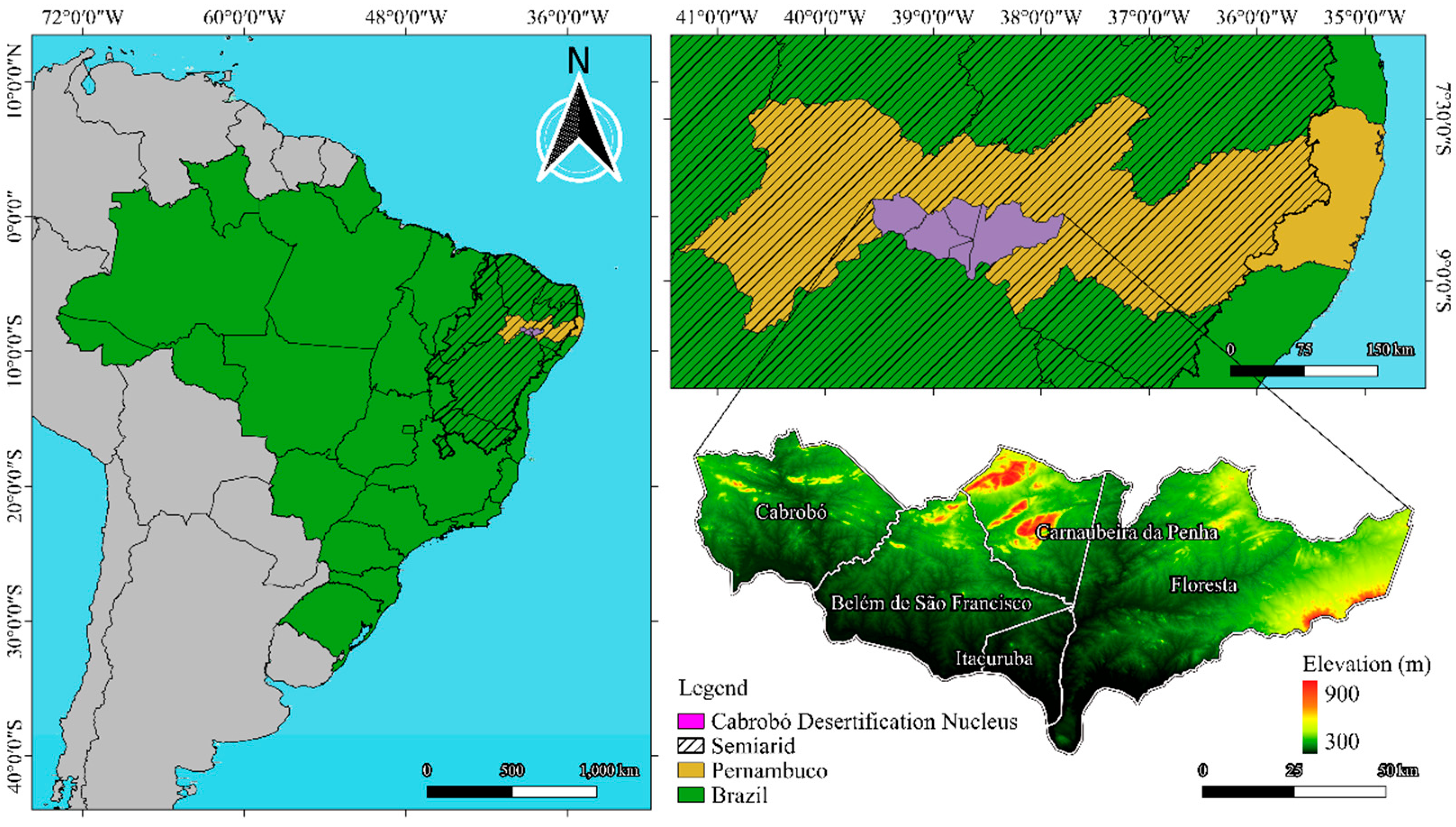
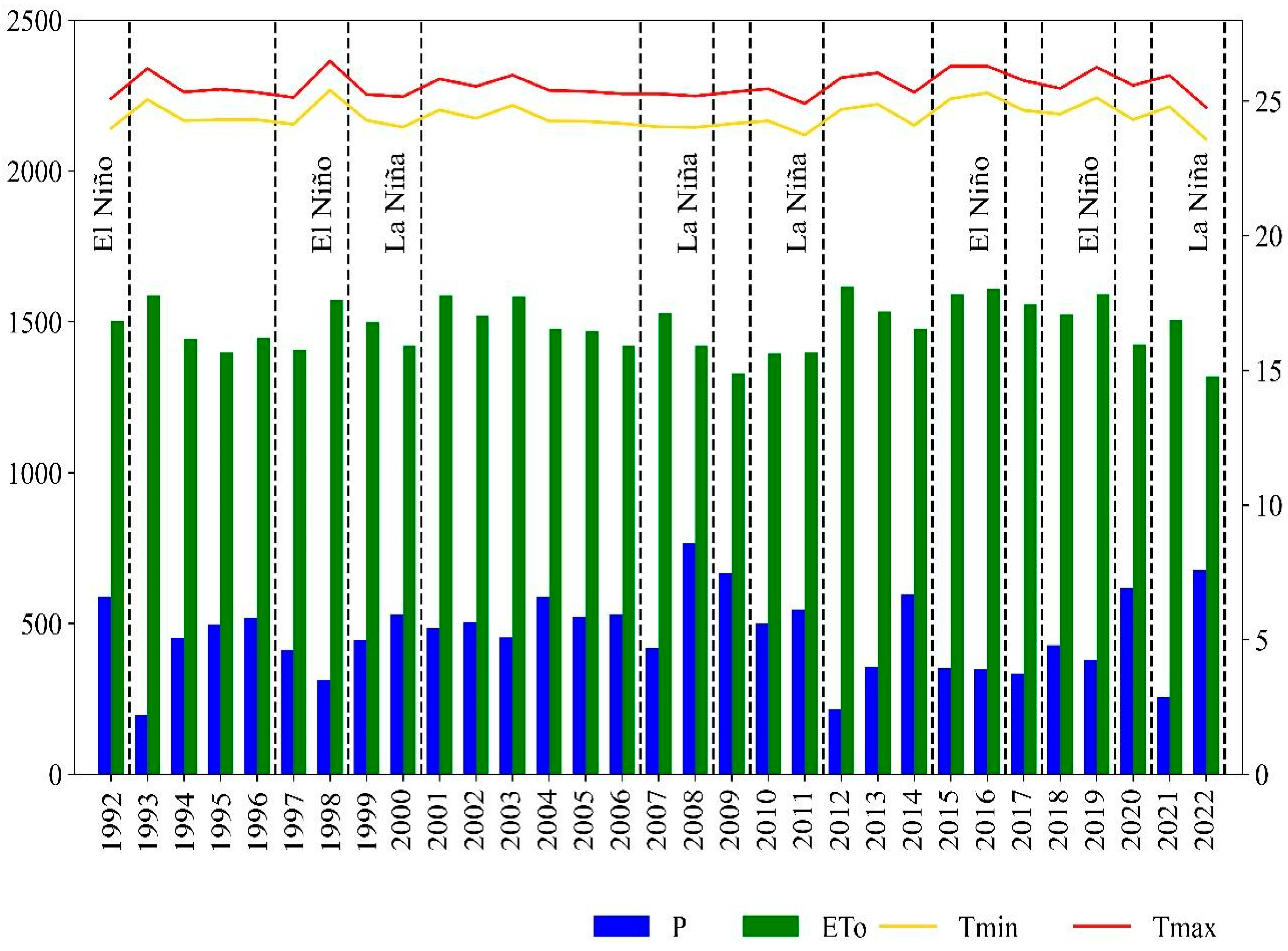

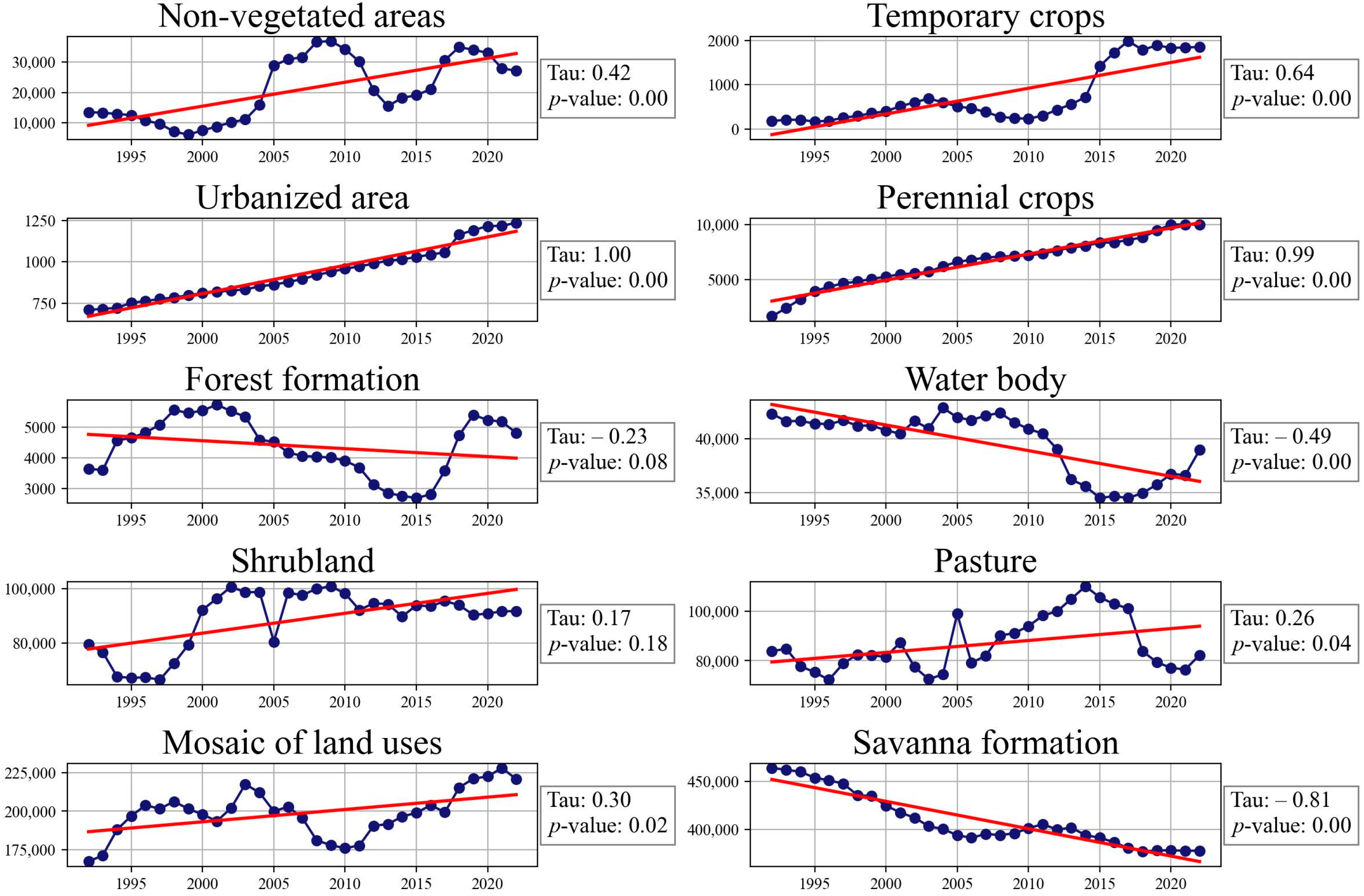
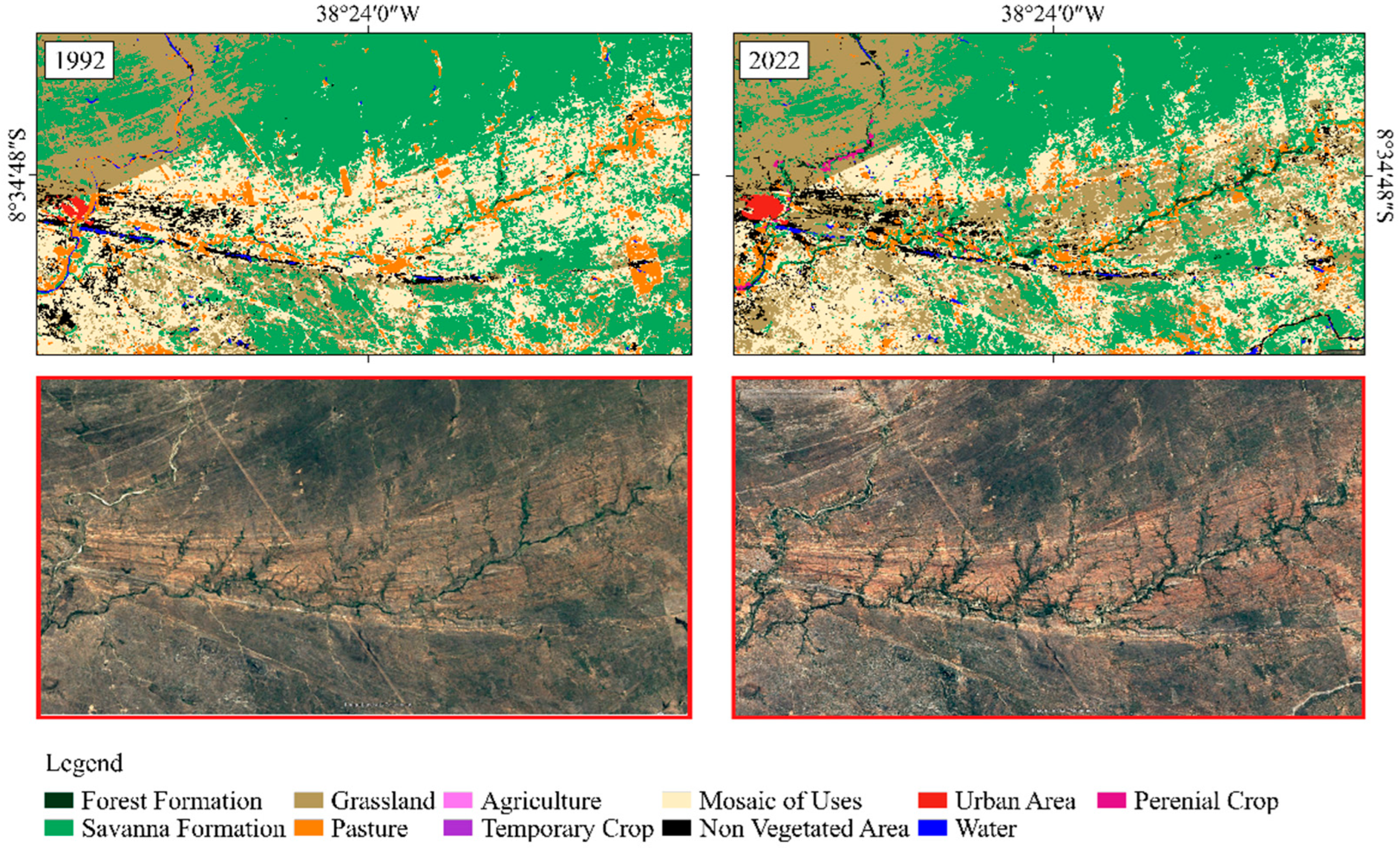
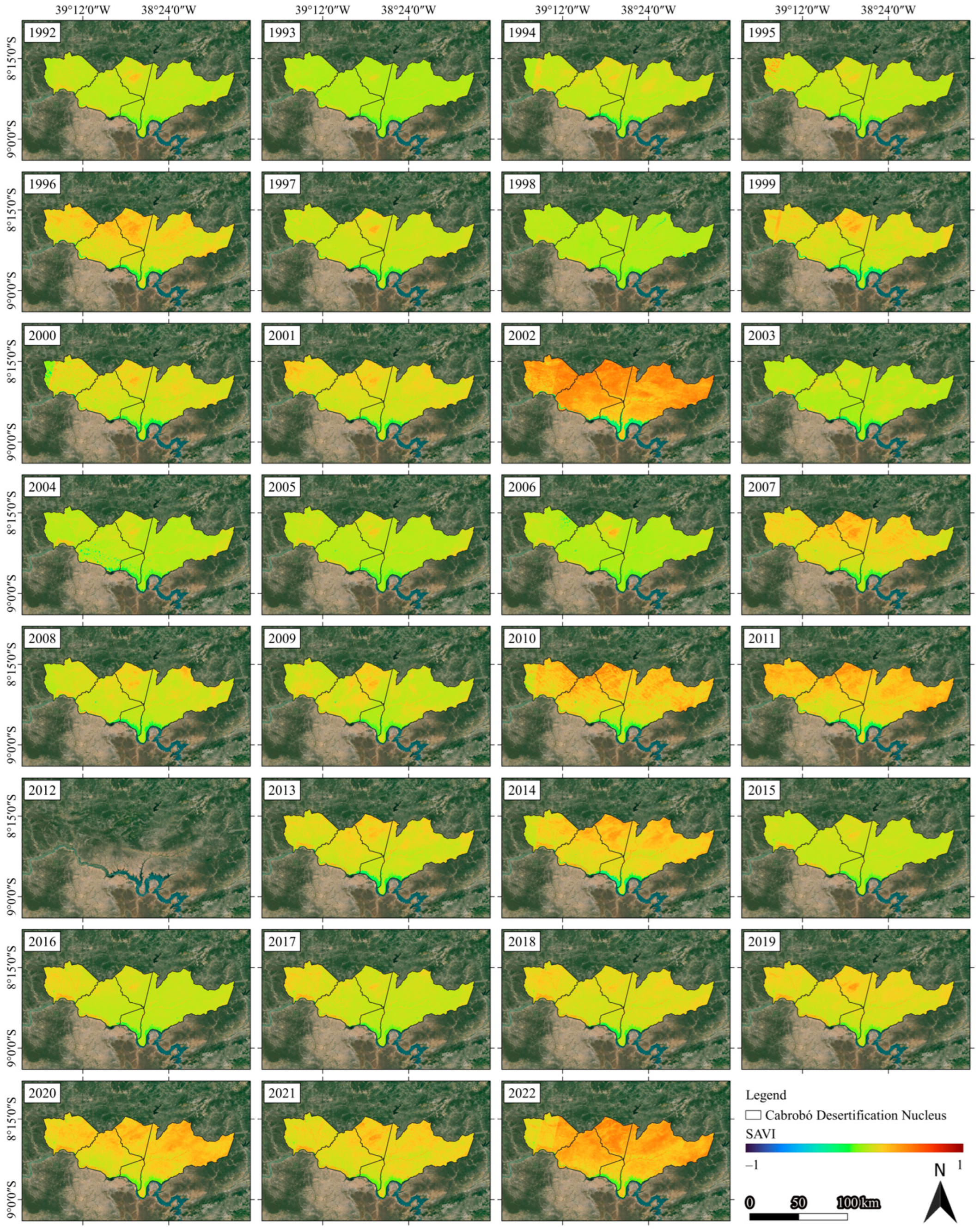
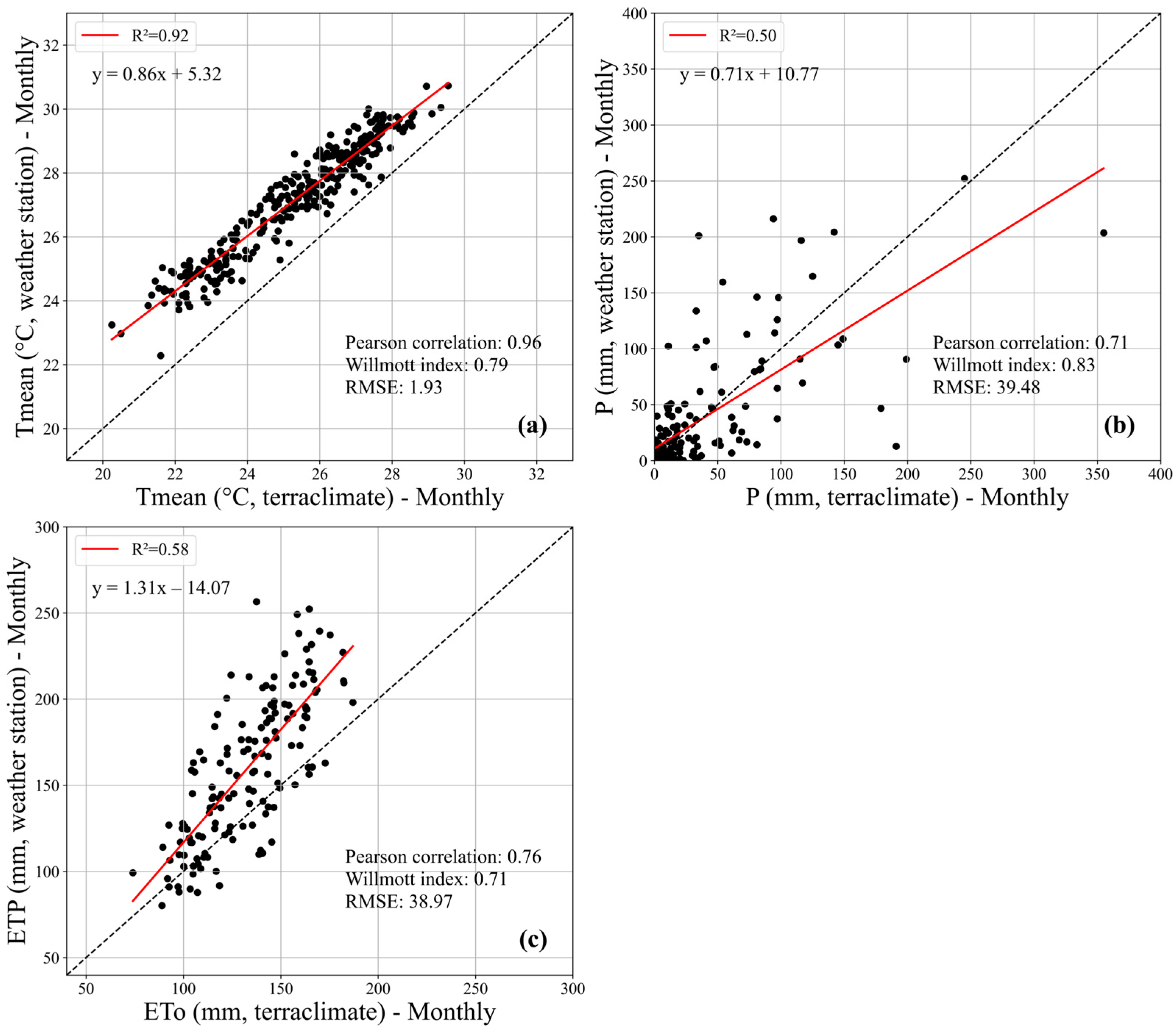
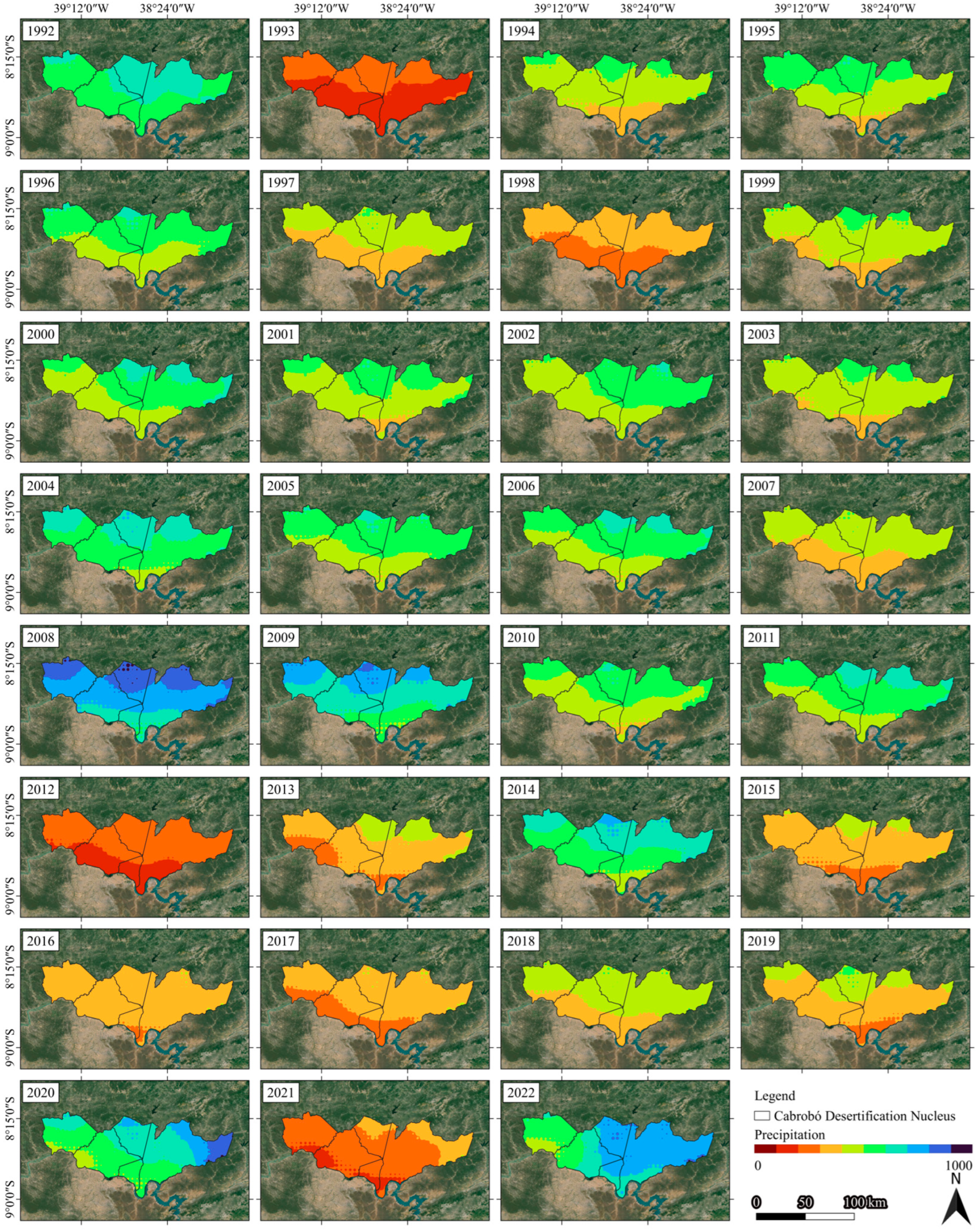
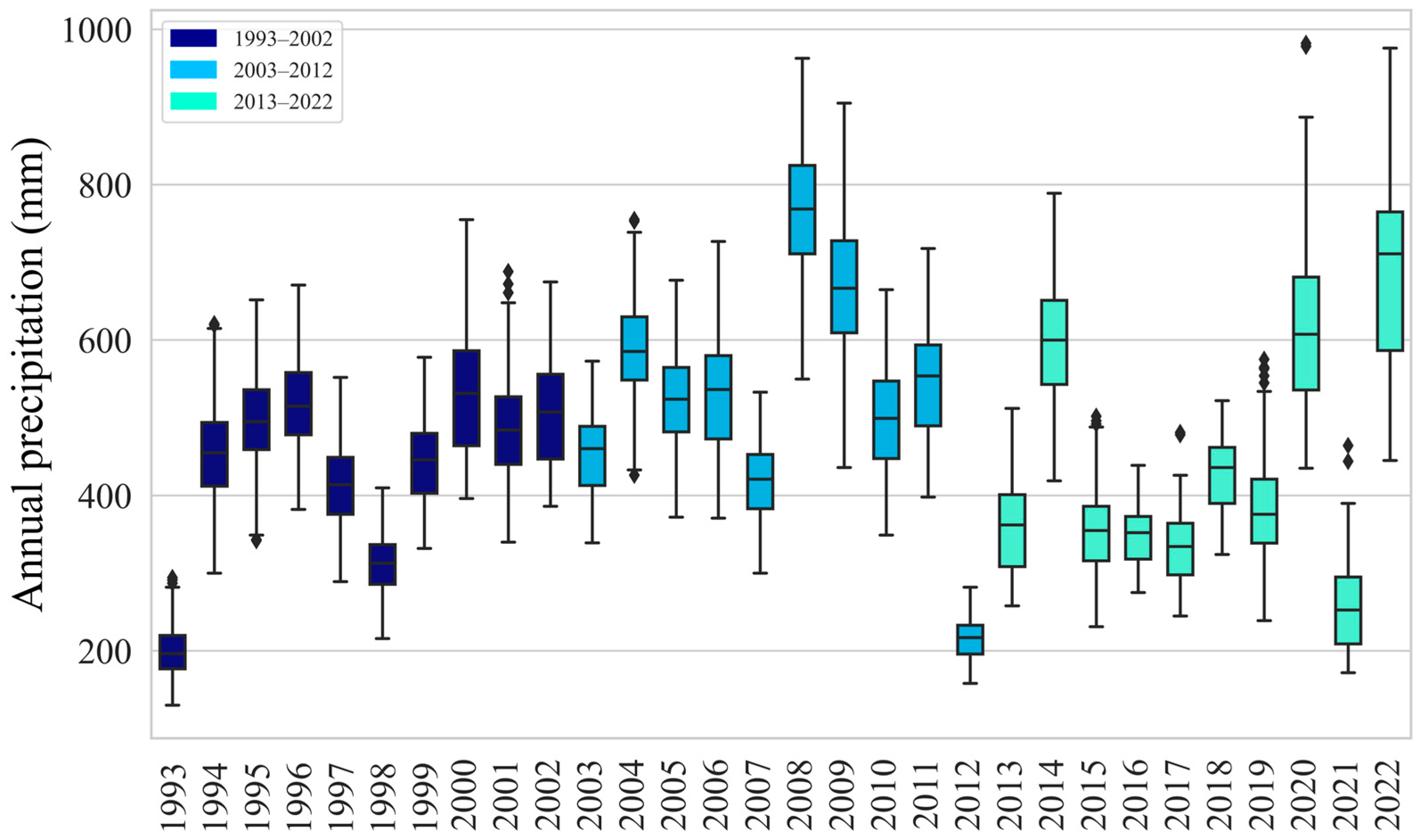

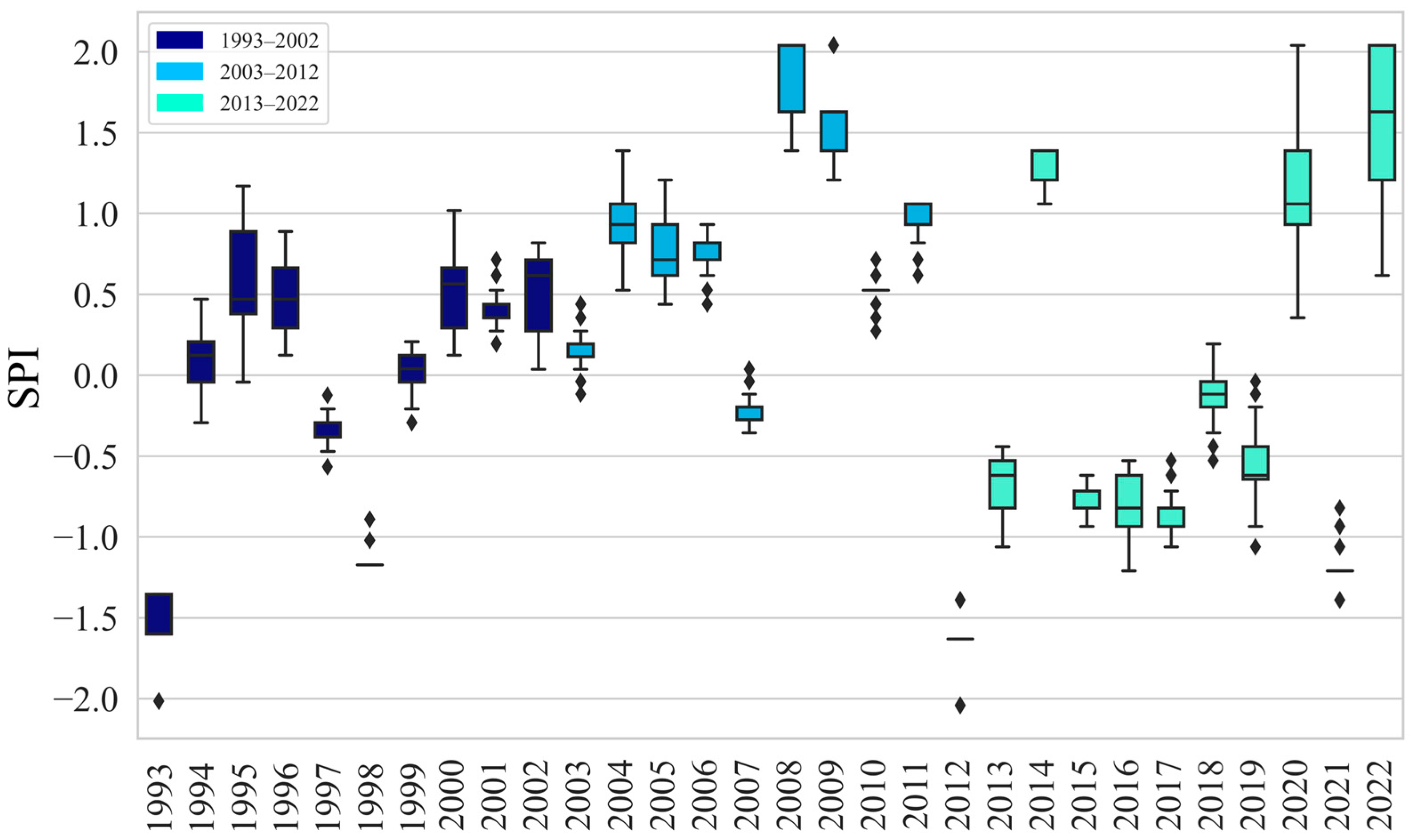
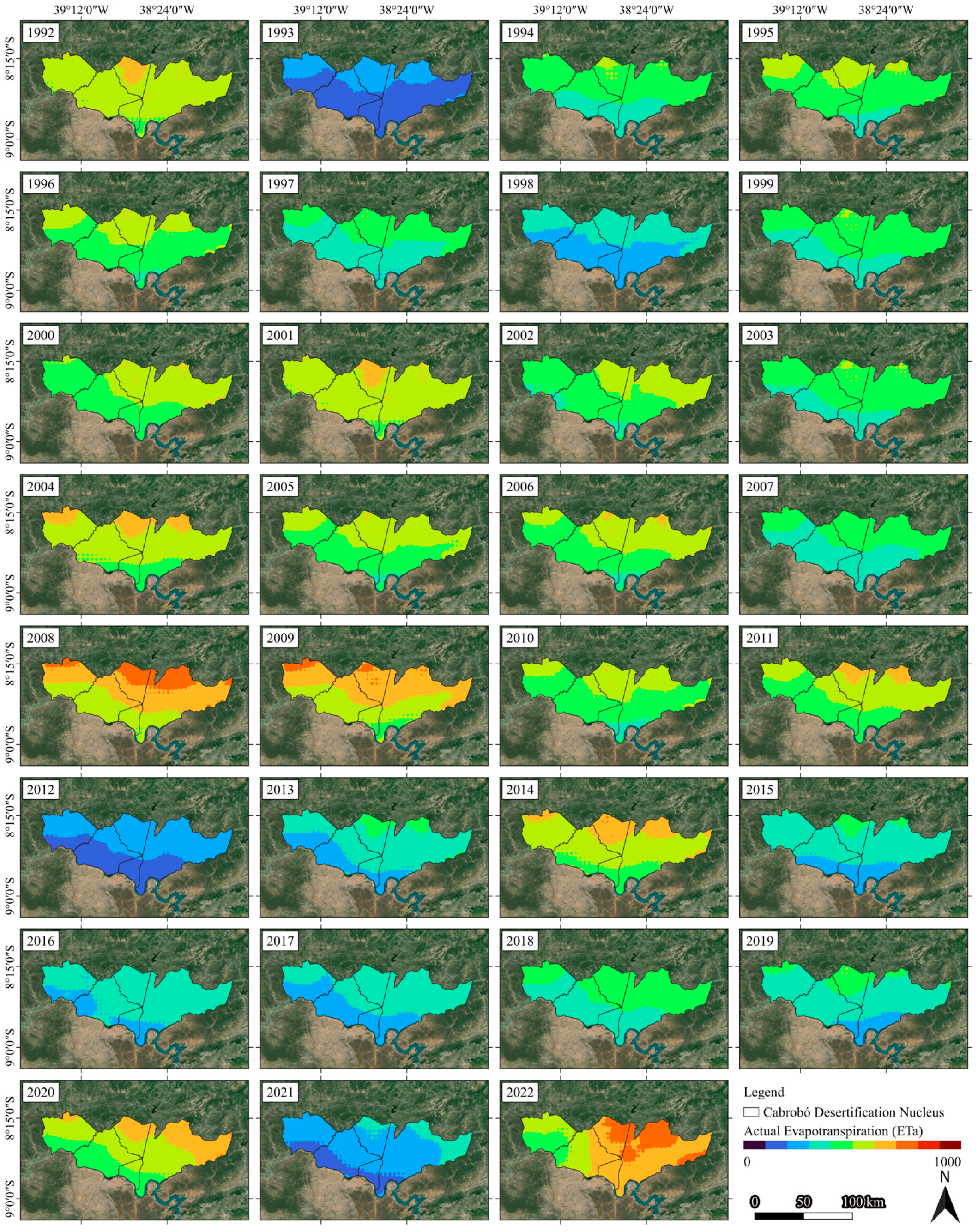
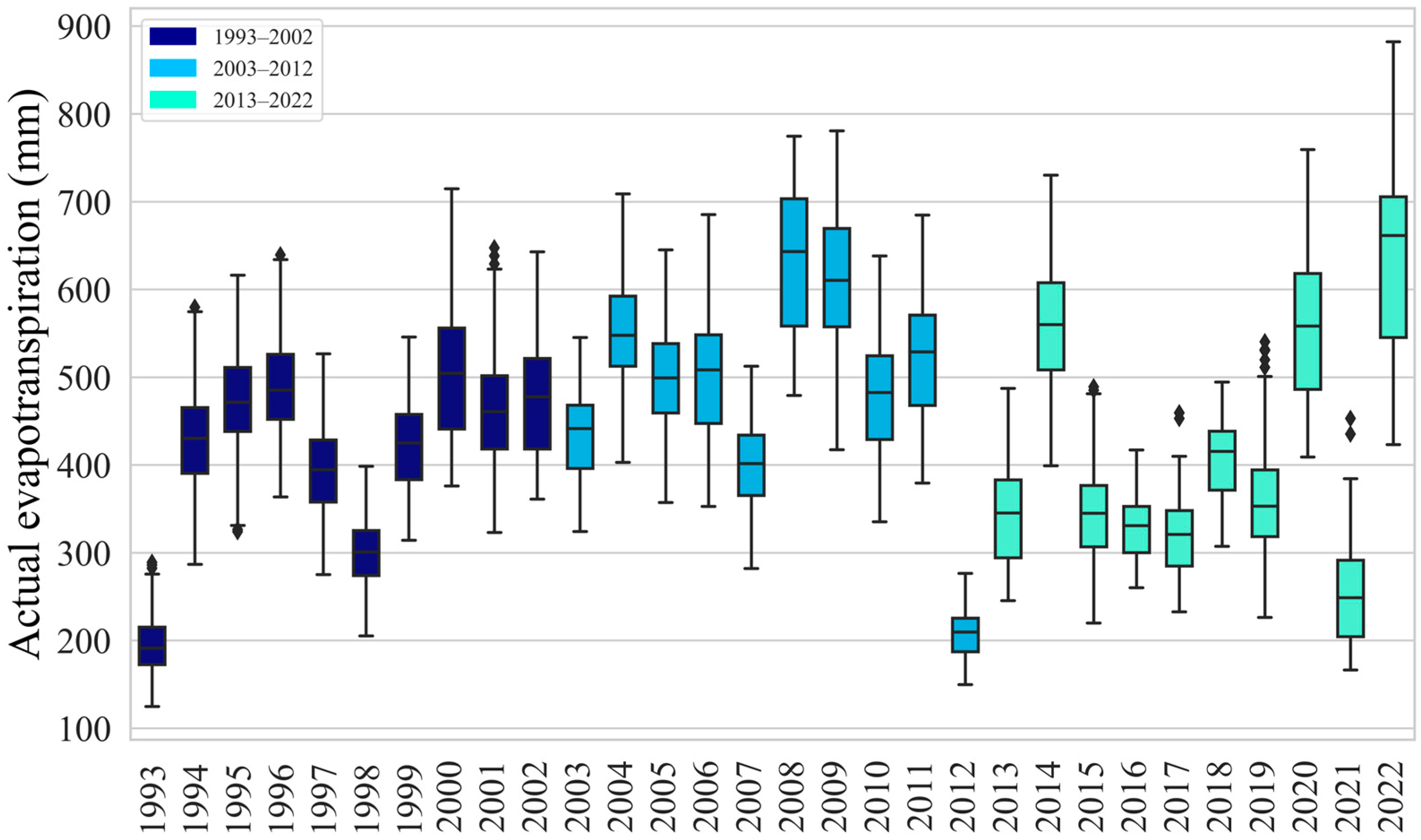
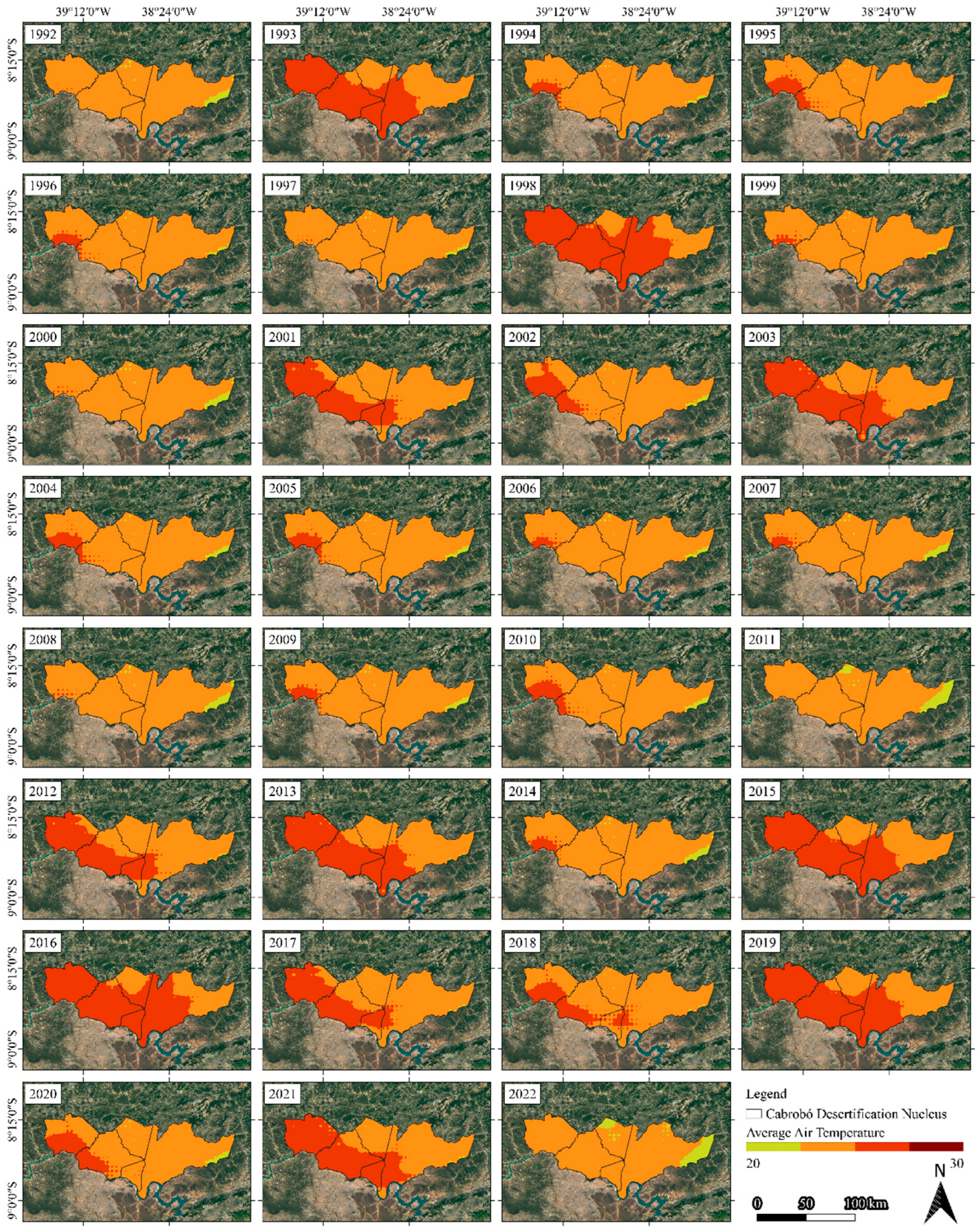

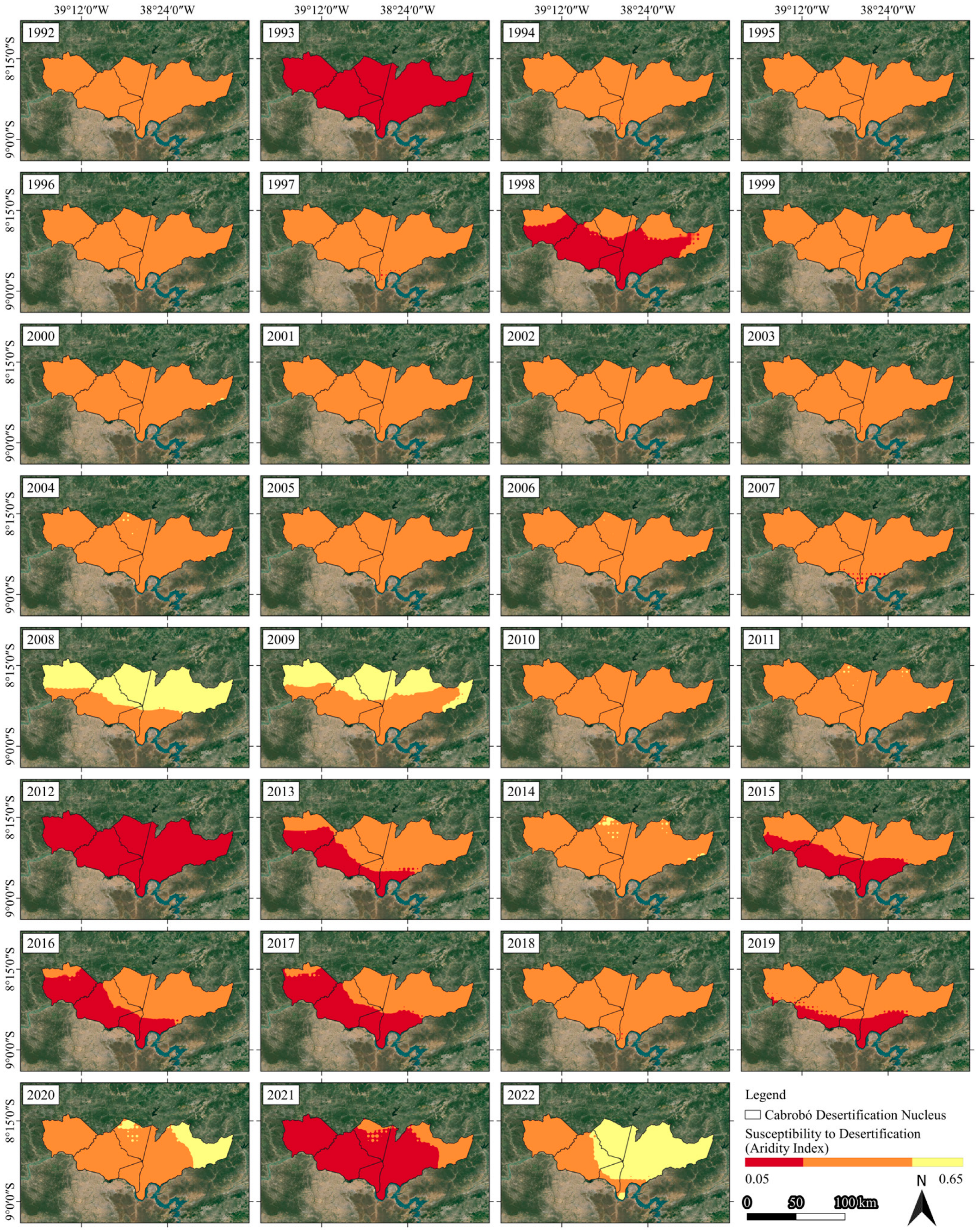
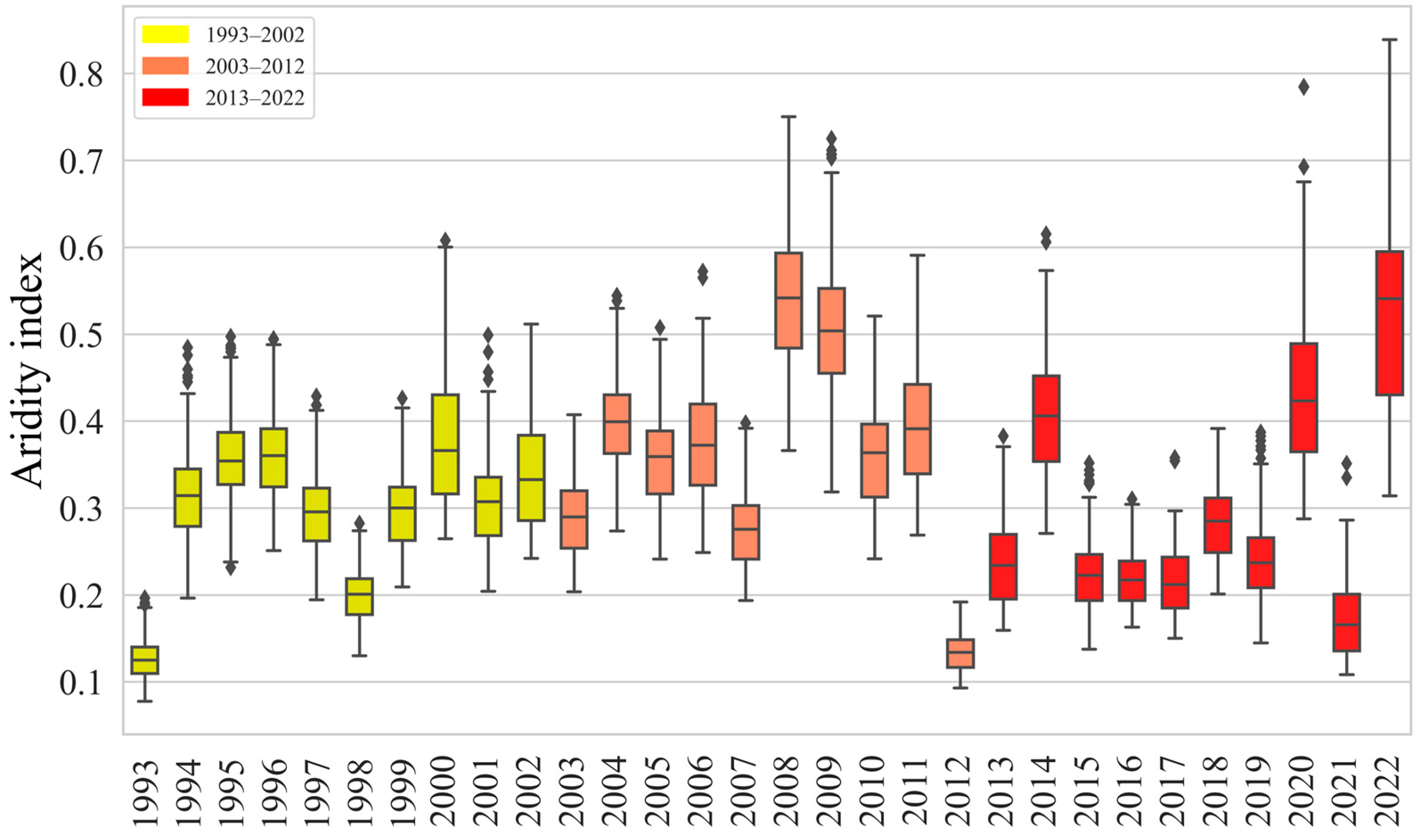
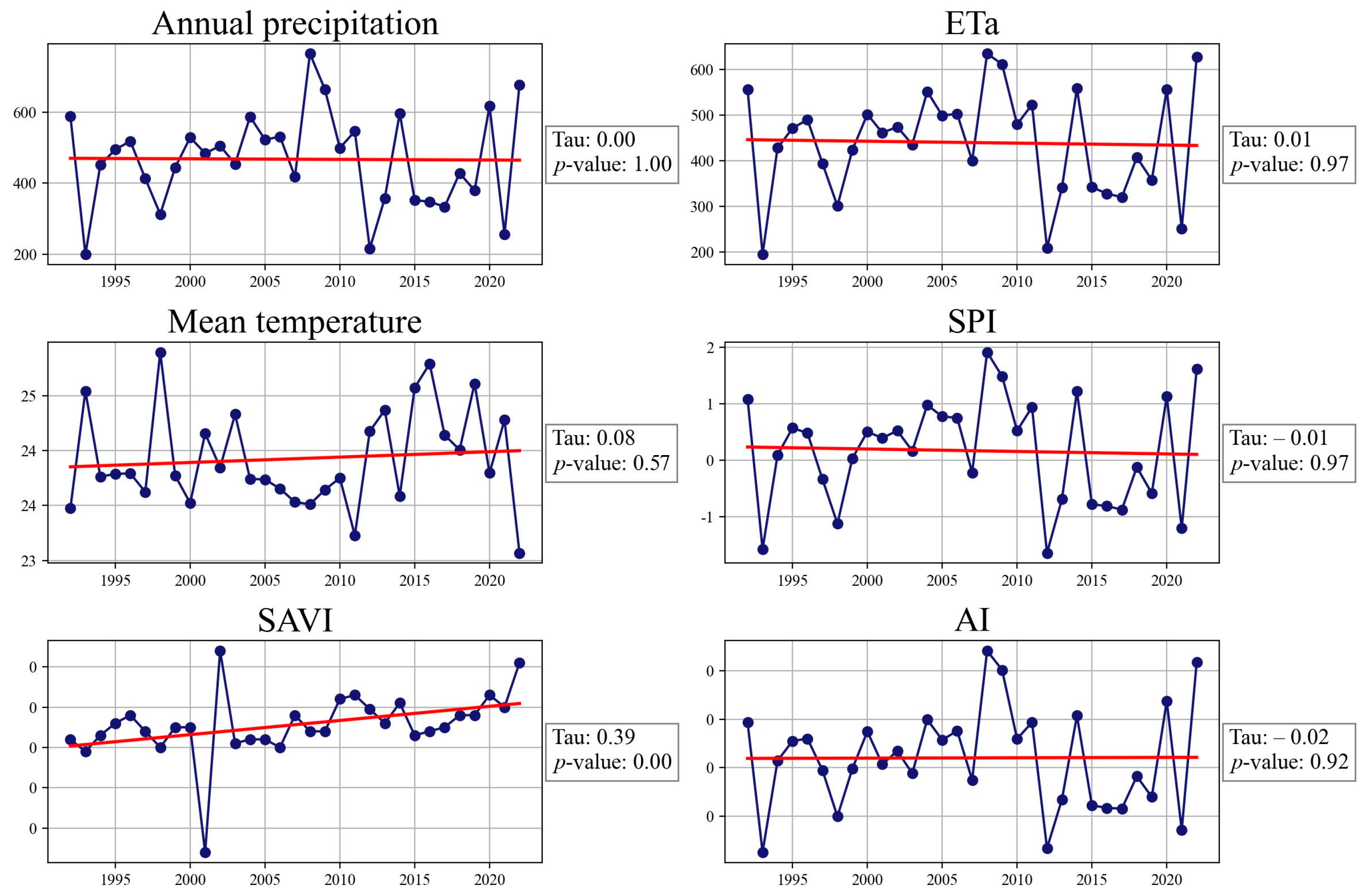
| Degree | Intervals | Classes |
|---|---|---|
| Extremely Wet | SPI > 2.0 | Wet |
| Severely Wet | 1.5 < SPI ≤ 2.0 | |
| Moderately Wet | 1.0 < SPI ≤ 1.5 | |
| Abnormally Wet | 0.5 < SPI ≤ 1.0 | |
| Normal | −0.50 < SPI ≤ 0.50 | Normal |
| Abnormally Dry | −0.5 > SPI ≥ −1.0 | Dry |
| Moderately Dry | −1.0 > SPI ≥ −1.5 | |
| Severely Dry | −1.5 > SPI ≥ −2.0 | |
| Extremely Dry | SPI < −2.0 |
| Climatic Classes | Aridity Index | Desertification Susceptibility Levels |
|---|---|---|
| Hyperarid | AI < 0.05 | Very High |
| Arid | 0.05 < AI < 0.20 | |
| Semi-arid | 0.21 < AI < 0.50 | High |
| Dry Subhumid | 0.51 < AI < 0.65 | Moderate |
| Humid Subhumid | AI > 0.65 |
Disclaimer/Publisher’s Note: The statements, opinions and data contained in all publications are solely those of the individual author(s) and contributor(s) and not of MDPI and/or the editor(s). MDPI and/or the editor(s) disclaim responsibility for any injury to people or property resulting from any ideas, methods, instructions or products referred to in the content. |
© 2024 by the authors. Licensee MDPI, Basel, Switzerland. This article is an open access article distributed under the terms and conditions of the Creative Commons Attribution (CC BY) license (https://creativecommons.org/licenses/by/4.0/).
Share and Cite
da Silva, J.L.P.; da Silva Junior, F.B.; de Souza Santos, J.P.A.; dos Santos Almeida, A.C.; da Silva, T.G.F.; Oliveira-Júnior, J.F.d.; Araújo Júnior, G.d.N.; Scheibel, C.H.; da Silva, J.L.B.; de Lima, J.L.M.P.; et al. Semi-Arid to Arid Scenario Shift: Is the Cabrobó Desertification Nucleus Becoming Arid? Remote Sens. 2024, 16, 2834. https://doi.org/10.3390/rs16152834
da Silva JLP, da Silva Junior FB, de Souza Santos JPA, dos Santos Almeida AC, da Silva TGF, Oliveira-Júnior JFd, Araújo Júnior GdN, Scheibel CH, da Silva JLB, de Lima JLMP, et al. Semi-Arid to Arid Scenario Shift: Is the Cabrobó Desertification Nucleus Becoming Arid? Remote Sensing. 2024; 16(15):2834. https://doi.org/10.3390/rs16152834
Chicago/Turabian Styleda Silva, José Lucas Pereira, Francisco Bento da Silva Junior, João Pedro Alves de Souza Santos, Alexsandro Claudio dos Santos Almeida, Thieres George Freire da Silva, José Francisco de Oliveira-Júnior, George do Nascimento Araújo Júnior, Christopher Horvath Scheibel, Jhon Lennon Bezerra da Silva, João Luís Mendes Pedroso de Lima, and et al. 2024. "Semi-Arid to Arid Scenario Shift: Is the Cabrobó Desertification Nucleus Becoming Arid?" Remote Sensing 16, no. 15: 2834. https://doi.org/10.3390/rs16152834
APA Styleda Silva, J. L. P., da Silva Junior, F. B., de Souza Santos, J. P. A., dos Santos Almeida, A. C., da Silva, T. G. F., Oliveira-Júnior, J. F. d., Araújo Júnior, G. d. N., Scheibel, C. H., da Silva, J. L. B., de Lima, J. L. M. P., & da Silva, M. V. (2024). Semi-Arid to Arid Scenario Shift: Is the Cabrobó Desertification Nucleus Becoming Arid? Remote Sensing, 16(15), 2834. https://doi.org/10.3390/rs16152834














